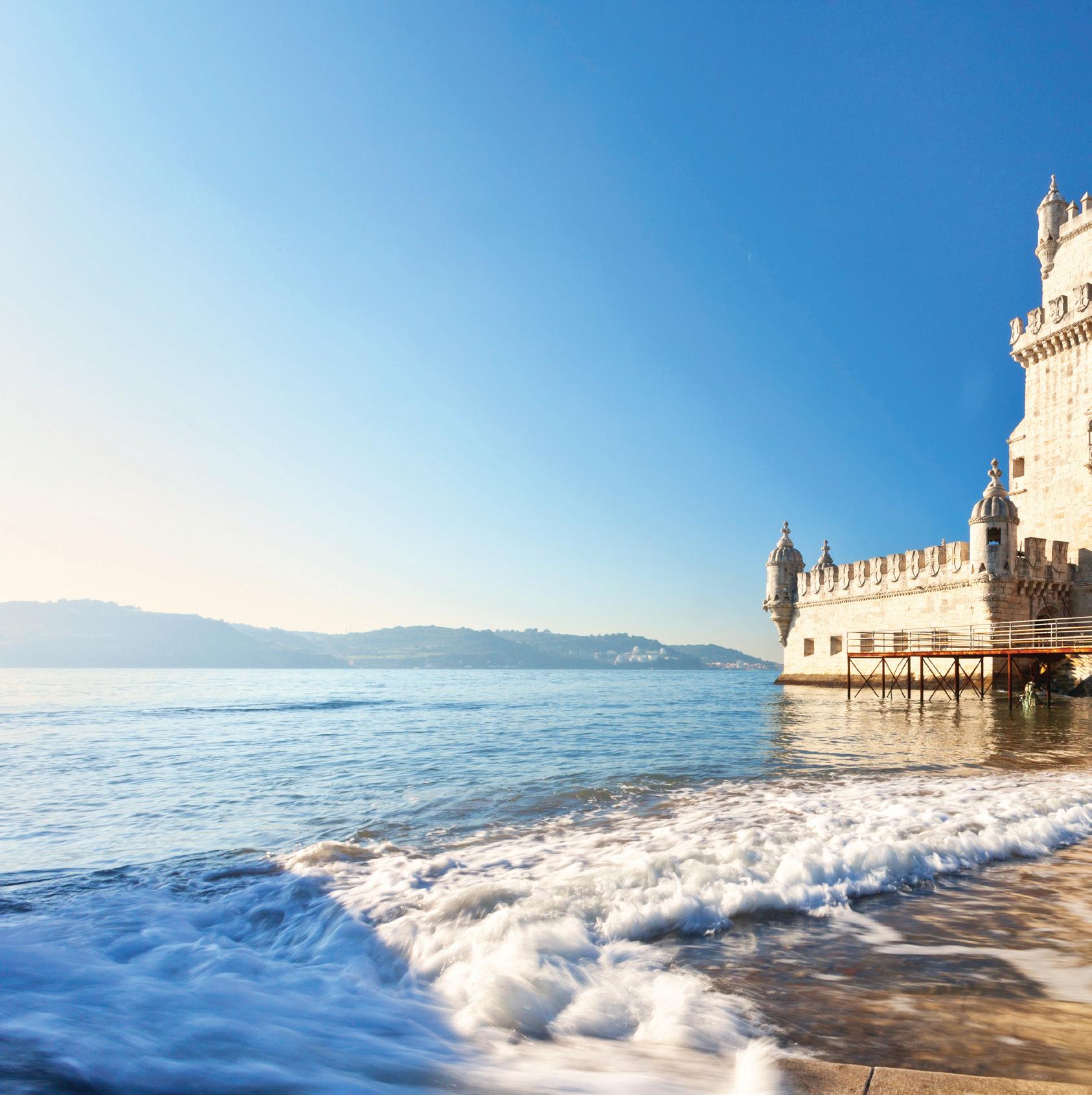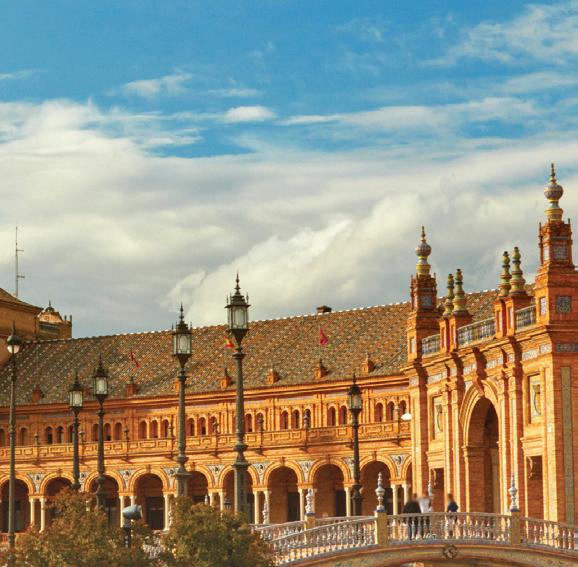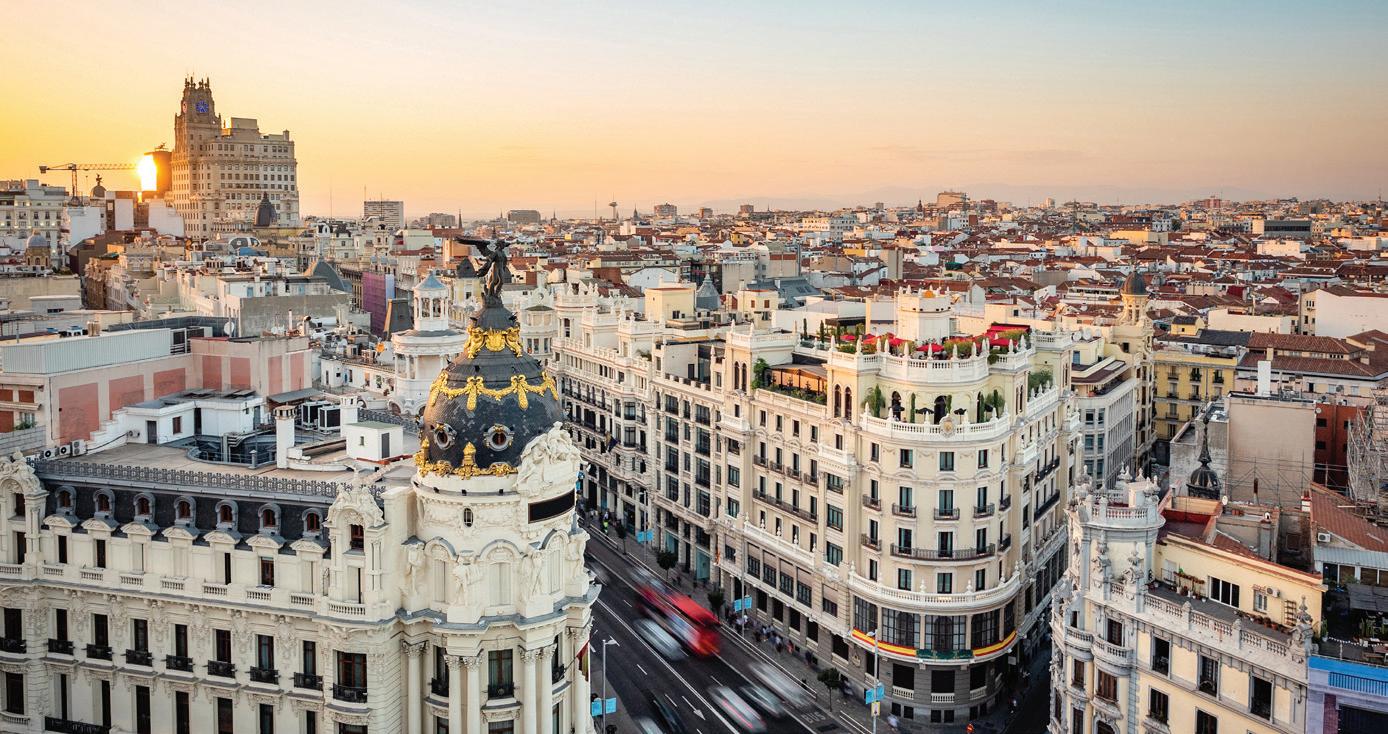














I am delighted to welcome you to this year’s edition of the Berkshire Hathaway HomeServices European Summer report.
Each year, we delve into the dynamics of the regions served by our network, as people from around the world flock to the continent to bask in the glorious sunshine and enjoy a little dolce vita.
For many—particularly Americans—the idea of owning a second home on the shores of Lake Como or Lake Maggiore, a waterfront masterpiece along Portugal’s stunning coastline, a residence within a premier community in Spain, or a chic pied-à-terre in London represents the ultimate dream. Now, more and more people are turning that dream into a reality.
A combination of political uncertainty at home and a relatively stable market in much of Europe is motivating many Americans with a spirit of wanderlust to finally take the plunge and purchase property abroad. It’s also proving to be a popular
choice as an investment vehicle for those seeking to further diversify their portfolios.
While the future of residency-by-investment programs such as the Golden Visa remains uncertain in some parts of Europe, countries that have phased them out are reporting no signs of slowdown, as global investment continues to pour in. Meanwhile, taxation—both its advantages and disadvantages—remains a key consideration for buyers across the board.
I invite you to explore the current real estate market trends and key influences in the pages that follow, with insights from our network leaders in Italy, Portugal, Spain, and the United Kingdom.
Wishing you a warm and joyful European summer.
Steve Ladd Chief Operating Officer Berkshire Hathaway HomeServices












Italy’s luxury property market remains resilient
Steady growth and stabilization define Italy’s real estate market in 2025, with home prices rising an average of 1.4% nationwide per year and continued demand amongst U.S. and other international buyers.
The biggest change affecting high-end buyers is in Italy’s “new-resident” flat-tax regime. New residents now pay an annual €200,000 on all foreign-source income—double the previous €100,000 cap, although those already in the program will see no increases. Despite the higher fee, the measure still offers a compelling tax incentive, and international inquiries and transactions in the luxury market have held firm.
Beyond the flat-tax route, overseas buyers most commonly pursue one of three visas: the Elective Residence Visa (ERV), the Investor (Golden) Visa, and the Self-Employment Visa. The ERV is a great choice for retirees with a passive income, while the Golden Visa requires investment in either a startup (€250,000 minimum), other established Italian companies (€500,000), government bonds (€2 million), or philanthropy (€1 million).
Italy offers a variety of property types at different price points. Apartments in cities like Milan and Rome continue to attract younger professionals and investors, but it’s luxury countryside properties that are seeing the strongest demand from abroad. “The current trend shows a marked preference for spacious, standalone properties that provide privacy, luxury, and a connection to
(apartment)

APRIL 2025 AVG. DAYS ON MARKET*
Milan Florence Lake Como
Lake Maggiore
Lake Como remains one of the hottest spots, especially for foreign buyers from the U.S., U.K., and Asia."
Marina Rizzotto Founder and CEO
Italy’s rich heritage,” said Marina Rizzotto, Founder and CEO of Berkshire Hathaway HomeServices Palazzo Estate, adding that luxury villas located in regions like Tuscany, the Italian Lakes, and coastal areas in particular are most popular with buyers today.
“Lake Como remains one of the hottest spots, especially for foreign buyers from the U.S., U.K., and Asia,” Rizzotto added. While, just over an hour’s drive west of Como, discerning buyers are increasingly turning their attention to Lake Maggiore.
“It’s all about tranquility and elegance,” Rizzotto said. “Strict building laws mean there’s not a lot of new construction, which keeps the market competitive for high-end, older properties.”
Tuscany has been attracting international buyers for decades thanks to its rustic charm and rolling vineyards, but there are other areas starting to rival the region in demand. Le Marche, situated on the Adriatic Coast, is gaining popularity among buyers from the U.K., Germany, and the Netherlands, thanks to its historic towns, natural beauty, and lower property prices. Elsewhere, the hills of Piedmont in the north-west of the country are “attracting buyers who want the Tuscany lifestyle but in a less crowded and more affordable setting.”

Inventory is tight across Italy’s most sought-after markets, and new construction hasn’t kept pace with growing demand from both domestic and international buyers. Americans account for nearly a third of all overseas inquiries, followed by the U.K., Germany, France and Canada.
In 2024, foreign buyers—especially from the U.S., U.K. and Germany— completed 8,100 transactions totaling more than €5 billion, at an average purchase price of around €640,000. Cash purchases account for roughly 60% of these deals, with the remaining 40% mortgage-financed.
Whether it ’s a lakeside villa, a countryside estate, or a chic inner-city apartment, Italy continues to captivate international buyers with its lifestyle, heritage and long-term value.

Portugal’s property market reignites
+10% average national property price increase since April 2024*
*Data provided by Berkshire Hathaway HomeServices Atlantic Portugal and Berkshire Hathaway HomeServices Portugal Property.
After a slow end to 2024 for Portugal’s real estate market, activity in mainland Europe’s most western country has picked up considerably in the first half of 2025 thanks to a variety of factors, including improved clarity surrounding avenues to residency, the relaxing of rental restrictions in certain areas, and an increase in direct flights from North American cities.
Property prices have risen an average of just over 10% nationally since April 2024, and while there were signs of a slight dip in overseas buyer transactions throughout 2024 while the industry adapted to updated visa requirements, this year has seen an increase in demand from foreign buyers, with the U.S., Canada, Brazil, France, the U.K., and China leading the charge in different regions of the country.
The Portuguese government introduced the Mais Habitação program in October 2023 which limited the scope of the Golden Visa so it no longer applied to real estate investments. The headline news was that the Golden Visa was sunsetting in Portugal, but this wasn’t accurate.
“If you invest in Portuguese funds to the tune of US$500,000, then you can get the Golden Visa,” explained Michael Vincent, CEO of Berkshire Hathaway HomeServices Portugal Property. “We found that people were initially hesitant to go down this route, but once they realized that it was the best way to go about gaining Portuguese residency, they got on board.”
Gonçalo Penedo, Business Director, Berkshire Hathaway HomeServices Atlantic Portugal, detailed a specific process that his team are using to help their clients obtain a Golden Visa. “One option is partnering with a professional fund manager,” he said. “In practice, then, if you want to obtain a Golden Visa, first you make the investment and become an investor with that developer. By the time construction is finished, your investment is converted into the property itself.”

Obtaining a Golden Visa isn’t the only way that overseas buyers can live in Portugal. The D7 and D8 visas are both popular options for retirees and “digital nomads” respectively. “The Golden Visa is still the most popular option, but digital nomads are well represented here in Portugal,” Penedo said. “We have lots of people coming to work in Portugal because we have good infrastructure—especially our coverage of fiber internet.” Portugal is one of the leading countries in Europe for fiber optic infrastructure with a significant portion of households having access to ultrafast fixed broadband (100 Mbps or more).
The Golden Visa is still the most popular option, but digital nomads are well represented here in Portugal."
Gonçalo Penedo Business Director

Portugal is the seventh safest country in the world according to the 2024 Global Peace Index—add to that the overall quality of life—and the bang for your buck."
Michael Vincent Founder and CEO
Berkshire Hathaway HomeServices
Portugal Property
Portugal started introducing short-term rental restrictions, particularly on new licenses, in 2023. But by the end of last year, the government had ended some of these restrictions. In larger cities like Lisbon and Porto, it’s still tough to acquire a license, but in the likes of the Algarve, Madeira, and the Azores, restrictions have loosened, which has in turn increased demand for properties in these areas, as second-home buyers and investors are seeking properties that they can rent out while they are not being utilized for personal use.
Looking at longer-term rentals, the steady flow of digital nomads into the country is keeping the rental market high in many areas. “Rental demand has increased in major cities especially,” Penedo said. “Tourism, the increase in digital nomads, and the shortage of long-term rental options are all putting pressure on rental prices.”


An increase in direct flights is the final reason why demand in Portugal is so hot among overseas buyers right now. “Accessibility is everything,” said Vincent. “We’ve got more direct flights from Toronto now which is quite big news, as well as direct flights between New York City and Faro which started in May 2025. This route was meant to start last year but United were under audit, so all their new routes were postponed.”

Portugal’s proven perks
Direct flights and various avenues to residency aren’t the only reasons overseas buyers are investing in the country. “Portugal continues to attract buyers thanks to its mild climate, safety, healthcare, education system, and lower real estate taxes,” said Penedo. Vincent agreed, adding, “Portugal is the seventh safest country in the world according to the 2024 Global Peace Index—add to that the overall quality of life—and the bang for your buck.”
“Another big factor right now is the political aspect,” Vincent said. “No matter what side of politics you’re on and what country you’re from, we’ve seen many people coming over because they are unhappy with where they have settled.”

While traditional vacation and second-home destinations—such as those in the Algarve, the Azores, and Madeira—continue to attract well-heeled buyers, many are turning their attention to other up-and-coming areas. “Comporta [just over an hour down the coast from Lisbon] is a very hip and happening area,” Vincent said. “That ’s where some of the rich and famous are buying from the U.S. It’s close to where Meghan and Harry are getting a place. There’s not much there—people come for the simplicity. There’s nothing but beautiful, beautiful beaches. But that seems to be the draw; buyers choose it to get away from the public eye and the paparazzi— it’s ultra, ultra exclusive.”

West of Lisbon, the popularity of upscale resort town Cascais continues to grow, while domestic and American second-home seekers alike are increasingly turning their attention to the Silver Coast, the coastal area north of Lisbon and south of Porto. “Demand is high for luxury villas in Cascais and, as such, we’re seeing price increases there that are higher than other areas of the country,” said Penedo. “Elsewhere, the Silver Coast is popular with upper class Portuguese buyers and our overseas clients. The area offers a really peaceful environment— there’s golf, horse riding, lots of nature, the ocean, castles, and the Óbidos Lagoon all nearby. Plus, you’re just an hour’s drive from Lisbon.”
for overseas buyers today









Golden Visa ends, but demand remains strong
One of the biggest developments in the Spanish real estate market over the past year has been the ending of the country’s Golden Visa program, which granted residency to non-EU nationals in exchange for real estate investment.
However, there are no signs of global buyers slowing down their interest in Spanish real estate, says Bruno Rabassa, CEO of Berkshire Hathaway HomeServices Spain.






Americans, he says, are still discovering new and exciting regions beyond the once very popular destination of Barcelona.
Costa Blanca, he notes, is the busiest region that his company serves—with the average price of a condo starting at €350,000 and a single-family residence around €1,200,000. Buyers from the Netherlands, Germany, the U.K., and the U.S. are primarily seeking properties with ocean views, swimming pools, and access to watersport amenities, he said.
The coastal community is in the Alicante province on Spain’s southeastern coast and is only a 2.5 hour train ride from bustling Madrid.
In Málaga, both short- and longterm rental demand has increased due to the city’s growing reputation as a comfortable place to live."
Bruno Rabassa CEO Berkshire Hathaway HomeServices Spain
Paired with ease of access, coastal beauty, and relatively affordable pricing, Rabassa says Costa Blanca offers everything that foreign buyers desire about Spain—favorable property taxes, safety, affordable healthcare, great weather year round, and a laidback lifestyle with a focus on health and well-being.
In addition, he added, qualifying foreigners are eligible to obtain a mortgage from a Spanish bank, with interest rates currently more favorable than those in the U.S.
Digital nomads fuel rental demand in Marbella and Málaga
In Marbella and Málaga, the digital nomad visa is proving to be a popular option for those who have the luxury of working from anywhere in the world and are not seeking permanent residence.
To obtain the visa, applicants must meet certain financial and educational requirements and show proof of their remote work or self-employment status. Family members may also be approved to join the applicant, and stays of up to five years can be granted.

“The only big deal would be to accommodate the different working time zones,” Rabassa said.
Both Marbella and Málaga are coastal towns located on the Costa del Sol in the south of Spain. With their relaxed lifestyle, access to aquatic amenities, and beautiful weather, Rabassa says these two destinations are very desirable for those wishing to reside there for a few years to work and enjoy all that Spain has to offer.
Digital nomads in Spain typically rent rather than buy property, Rabassa explained. Given this trend and the rising popularity of both Marbella and Málaga, demand for rental properties in each city is on the rise.
“In Málaga, both short- and long-term rental demand has increased due to the city’s growing reputation as a comfortable place to live,” Rabassa said. “In Marbella, short-term rentals have decreased due to new regulations, but long-term rentals are increasing.”

The Spanish capital of Madrid is currently a trending location for foreigners to buy property—with prices increasing around 15% to 20% year over year. Today, the average condo price starts at around €1,500,000, and a single-family residence at €3,000,000.
“Madrid is in fashion, and everyone wants to own a property here,” said Rabassa. “The prices are still very competitive with the best European cities.”
Rabassa says about 90% of the transactions his company completed last year in Madrid were for foreign buyers. Buyers hailing from the U.S., Latin America, and Asia are generally seeking classic turn-of-the-century buildings with modern technological conveniences.
But with increased demand in Madrid has come decreased inventory. Given this, Rabassa says prices are expected to continue rising.


Inventory levels are low in the most popular regions of Spain—Madrid, Marbella, Barcelona, Málaga, Mallorca, and Costa Blanca.
Rabassa shared that the volume of new housing has declined drastically across the country since 2013, citing the increasing cost of building supplies, a shortage of labor, and the difficulty developers face in securing financing.
The combination of increased demand, low inventory, and rising prices has created a sense of urgency in the market.
“The best time to buy in Spain?” he said. “Today, rather than tomorrow.”

Madrid is in fashion, and everyone wants to own a property here.
The prices are still very competitive with the best European cities."
Bruno Rabassa CEO Berkshire Hathaway HomeServices
High-end communities attract high flyers
Throughout Spain, many high-end communities have been coming into the focus of luxury buyers in recent years.
One such community—Sotogrande, the largest privately-owned residential development in Andalusia—caters to more discerning buyers seeking privacy, first-class amenities, and the ultimate in luxury real estate.
Founded in 1962 by American industrialist Joseph McMicking, Sotogrande was conceived as a European counterpart to California’s coastal luxury communities.
In fact, Rabassa says of Sotogrande, “You may think you are in California because of how it has been developed.”
Today, residents of Sotogrande pay handsomely to secure their property, ranging from the low millions to €20 million and above. The cost of homeownership in Sotogrande also comes with many perks—prestigious golf courses, marina with shops, restaurants, art galleries, racquet center, beach club, equestrian facilities, and more.


London calling—stability draws U.S. buyers
5.1%
Increase in single-family home prices in Chelsea since April 2024. *
With its rich history, timeless elegance, and vibrant lifestyle, London is one of the most in-demand cosmopolitan cities in the world, continuing to attract well-heeled buyers seeking exquisite properties within a resilient and stable market.
Since the change of administration in the U.S., Martin Bikhit, Managing Director of Berkshire Hathaway HomeServices London, reports an uptick in American buyers seeking residences in prime central London.
“The majority of the American buyers are looking for a pied-à-terre in London, as opposed to a four-bedroom home,” said Bikhit. “So when they return to California or New York, they know their properties are nice and secure.”
Permanent residence is not the goal of these buyers; instead they are seeking relatively well-priced investments in a stable environment, with an anticipated capital growth of 10–15% over the next five years, he said. Some buyers are opting to replace their vacation residences in the Hamptons and other traditional U.S. second-home markets with a London property or simply diversify their portfolios abroad.

Matt Staton, Head of Residential at Berkshire Hathaway HomeServices London, says that it’s a buyer’s market in prime central London—especially if the buyer is working with cash. Foreign buyers are taking advantage of the relatively “well-priced” real estate in the city, he explained.
For the ultra-wealthy, the end of 2024 and the start of 2025 have seen a flurry of multi-million-pound transactions take place—£42 million in Holland Park, £80 million in Chelsea, and £139 million in Regent’s Park to name a few.
A recent change in taxation for nondomiciled (non-dom) individuals—people living in the U.K. but having their home overseas for tax purposes—also adds to the appeal of investing in the market.
The new rule allows people who have just arrived in the country to not pay any tax on foreign income and capital gains for the first four years of residing in the U.K.
Meanwhile, Staton explained that the domestic market is a little constrained as interest rates have not come down as swiftly as expected. With the relatively high cost of borrowing, some buyers are opting to take a “wait-and-see” approach and continue to rent while saving for their down payment.

City living edges out country appeal
The allure of city living is drawing buyers back to the heart of bustling London after many headed for the countryside in search of space and serenity during the pandemic.
Bikhit and Staton agree that Chelsea, Marylebone, Knightsbridge, Mayfair, and Notting Hill are popular locales in London to buy—noted for their shopping, dining, nightlife, schools, and worldwide name recognition among the elite as part of the draw.
In Mayfair, Chelsea, and Notting Hill, between 63% and 80% of properties have been on the market for over three months, with prices decreasing for flats and single-family homes year-overyear, except for homes in Chelsea, which have increased by 5.1%.
Ranging in average price from £1,269,456 for a flat in Notting Hill to a single-family home in Mayfair for £13 million, London’s high-end property market showcases an array of prestigious residences, offering unparalleled luxury, exclusivity, and exceptional value in some of the world’s most sought-after addresses.
The majority of the American buyers are looking for a piedà-terre in London, as opposed to a fourbedroom home."
Martin
Bikhit
Managing Director